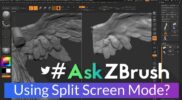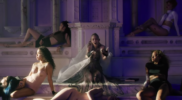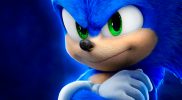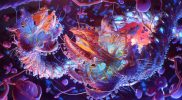by Anders Rådén
Umberto Boccioni (1882-1916) was an influential Italian painter and sculptor (01). He helped shape the revolutionary aesthetic of the Futurism movement as one of its principal figures. He was born in Reggio Calabria and after his arts education he settled in Milan. In early 1910 he met F. T. Marinetti, who had already published his Manifesto del Futurismo (“Manifesto of Futurism”) in the previous year. Boccioni became the main theorist of the new artistic movement, which glorified modernity and emphasized the technological and industrial triumph of humanity over nature. Although he had no previous experience, he decided to be a sculptor after having visited various studios in Paris in 1912. Within a short time he had sculpted 10-15 major works, one of which is the iconic Unique Forms of Continuity in Space (02). Preceding this, Boccioni sculpted three similar “striding” figures:
- Synthesis of Human Dynamism (03)
- Speeding Muscles (04)
- Spiral Expansion of Muscles in Movement (06)

All of these try to solve the problem of capturing a “synthetic continuity” of motion, integrating surrounding architectural elements – even the perceived movement of air – into the sculpture. The first to be sculpted, Synthesis of Human Dynamism, has a complexity that later sculptures progressively lack. In the second sculpture, Speeding Muscles, there is no longer any hair, nipple and navel. The left arm has been reduced in length and the architectural elements are restricted to a house/head and a keel protruding from the breast. The next sculpture, Spiral Expansion of Muscles in Movement, further reduces the arms and only retains rudiments of architectural structures. Finally, arriving at Unique Forms of Continuity in Space, Boccioni perfected the simplicity of the striding motion.
Boccioni never lived to see his works gaining appreciation. Only three years after having created these sculptures he died after falling from his horse during a military training exercise. Even more tragically, in 1927 the three striding sculptures were destroyed by the artist who had stored them after Boccioni’s death. Unique Forms of Continuity in Space was saved since it had been sold beforehand. It was later cast in bronze, and one of those casts was sold only last week at the auction house Christie’s in New York. It was estimated to fetch $4.5 million, but sold for an incredible $16 million. This shows just how much sought after Boccioni’s works are today.
I became involved in this project when I decided to try my hand at sculpting Speeding Muscles. I have a long experience of using ZBrush in my work as a digital illustrator, and my work has varied from anatomical cross-sections of sea squirts and hoverfly genitalia (!) to voles and dinosaurs. I have always loved Boccioni and wanted to have a new challenge. I knew from earlier that another digital artist, Matt Smith, had crowd-funded the recreation of Spiral Expansion of Muscles in Movement, so I was not going to compete with that. I had seen the two available photographs of Speeding Muscles, and I thought I would give it a go to see if something could be made out of it. To my surprise it partly sculpted itself, since the striding movement is so inherent in what can be interpreted from the photos. I felt that very little had to be conjecturally added in areas where there is no photographic coverage. I printed the result on my home 3D printer and published it together with the photographs on Twitter, and almost immediately Matt contacted me. That is how we decided to collaborate on reconstructing the striding sculptures: these are united in that they were all made of plaster and describe a sort of evolutionary development towards Unique Forms of Continuity in Space, which we thought would be very interesting to experience in a gallery setting.
I went to London in February after Matt had set up a meeting with Estorick Museum to investigate whether they would be interested in being involved. Luckily they were very enthusiastic and gave us a date for a Boccioni – The Lost Sculptures Recreated exhibition; 15th September. The most complicated sculpture still remained to be done (Synthesis of Human Dynamism), and we also decided to include a miniature version of Unique Forms of Continuity in Space even though it still exists. We wanted to “reverse-engineer” it back to the original plaster, of which there are several 1913 photos (06). Actually, the original plaster is on display at the Modern Arts Museum in Saõ Paulo, Brazil, but several layers of restoration during almost 100 years have distorted it so that it deviates from what it once looked like.
I also started hunting for historical high-resolution photographs. This actually proved to be the most arduous and time-consuming task of the whole project. Most of the 30 or so photographs of the sculptures are located in private collections in Italy, and some of them have only been published once or twice in obscure exhibition catalogues.
Using ZBrush, the resulting photographs were loaded as reference views in the Image Plane function. This way the orientation could be rapidly shifted, which was crucial during the sculpting process for comparing intricate details from different angles (07). Changing the Model Opacity made it easier to “trace” the contours of the photographs. The brushes I used most frequently were Clay; DamStandard; Move Topological; Polish and Inflate. The Sculptris Pro mode was a real lifesaver for restoring topology where polygons were too stretched or scrunched together. Complex mesh details, for example the hair on Synthesis of Human Dynamism, were projected onto the mesh by making an alpha from the hair section in the photo. There was a lot of going back and forth between Matt and me discussing how to solve different anatomical problems (08-09). Finally, the 3D Print Hub plugin was used to fix the sizes of the sculptures, and then they were exported as .stl files.

During summer we contracted three companies in the UK to print the sculptures, and the two techniques used were PLA printing and polystyrene foam milling. The experience of finally seeing these remarkable sculptures in full size – really for the first time since 1927 – is hard to describe in words (10). The exhibition at Estorick continues until 22 December.















